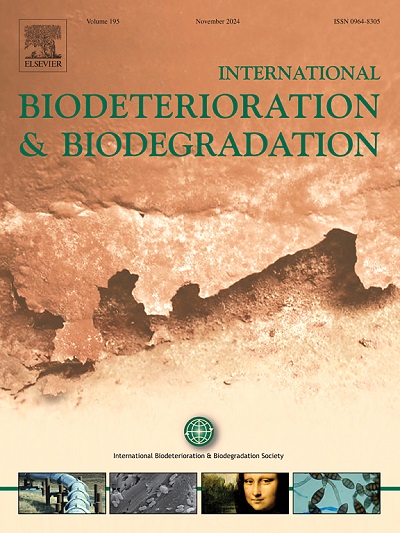双歧杆菌BL1对1,2-二氯乙烷的生物降解:在污染土壤中的降解特性、分解代谢基因和生物强化
IF 4.1
2区 环境科学与生态学
Q2 BIOTECHNOLOGY & APPLIED MICROBIOLOGY
International Biodeterioration & Biodegradation
Pub Date : 2025-05-12
DOI:10.1016/j.ibiod.2025.106123
引用次数: 0
摘要
1,2-二氯乙烷(1,2- dca)污染已成为对人类健康和生态稳定的重大威胁。然而,对1,2- dca污染土壤的研究还很有限。此外,能够好氧降解1,2- dca的细菌属的修复潜力及其在修复实际1,2- dca污染土壤中的应用尚未得到全面的研究。为了解决这些研究空白,在本研究中,我们从1,2- dca污染的土壤中分离到一种新的1,2- dca降解细菌,通过16s rRNA基因分析和生理生化测试鉴定为Ancylobacter sp. BL1。利用响应面法预测了菌株BL1的最佳降解条件,并对其降解动力学进行了研究。菌株BL1中1,2- dca的代谢途径遵循水解脱卤机制。参与1,2- dca降解的关键基因(dhlA、dhlB、max和ald)与先前报道的基因具有显著的同源性,除了dhlB与dhlA一起位于一个大质粒上。据我们所知,这是首次利用高效的1,2- dca降解菌株BL1修复实际1,2- dca污染的土壤。结果表明,菌株BL1在5天内有效降解土壤中235 mg/kg的1,2- dca约86%。分离菌株的生物强化对土壤原有微生物群落没有明显干扰,增加了有利于有机碳降解和恢复土壤酶活性的微生物菌群丰度。本研究将为1,2- dca污染土壤的生物修复提供基础。本文章由计算机程序翻译,如有差异,请以英文原文为准。
Biodegradation of 1,2-dichloroethane by Ancylobacter sp. BL1: Degradation characteristics, catabolic genes, and bioaugmentation in contaminated soil
1,2-dichloroethane (1,2-DCA) contamination has emerged as a notable threat to human health and ecological stability. However, studies on 1,2-DCA-contaminated soils are limited. Further, the remediation potential of bacterial genera capable of the aerobic degradation of 1,2-DCA and their use in the remediation of actual 1,2-DCA-contaminated soils have not yet been comprehensively investigated. To address these research gaps, in the present study, we isolated a novel 1,2-DCA-degrading bacterial strain from 1,2-DCA contaminated soil, identified as Ancylobacter sp. BL1 using 16 S rRNA gene analysis and physiological and biochemical tests. The optimal conditions for degradation by strain BL1 were predicted using response surface methodology, and the degradation kinetics was studied. The metabolic pathway of 1,2-DCA in strain BL1 follows a hydrolytic dehalogenation mechanism. The key genes (dhlA, dhlB, max, and ald) involved in 1,2-DCA degradation exhibited significant homology with previously reported genes except for dhlB, which was located on a large plasmid together with dhlA. To the best of our knowledge, for the first time, an efficient 1,2-DCA-degrading strain, BL1, was utilized for remediating actual 1,2-DCA-contaminated soil. Our findings demonstrated that strain BL1 effectively degraded approximately 86 % of 235 mg/kg of soil 1,2-DCA within 5 days. Bioaugmentation with the isolated strain did not considerably disturb the original microbial communities of the soil, increasing the abundances of microbial flora beneficial to organic carbon degradation and restoring soil enzyme activity. Our study will provide a foundation for the bioremediation of 1,2-DCA-polluted soil.
求助全文
通过发布文献求助,成功后即可免费获取论文全文。
去求助
来源期刊
CiteScore
9.60
自引率
10.40%
发文量
107
审稿时长
21 days
期刊介绍:
International Biodeterioration and Biodegradation publishes original research papers and reviews on the biological causes of deterioration or degradation.

 求助内容:
求助内容: 应助结果提醒方式:
应助结果提醒方式:


